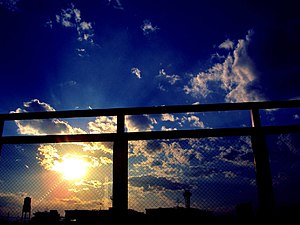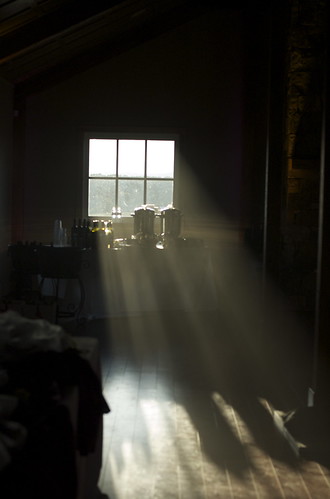Image taken from TraderZed's Flickr photostream under CC license
Unlike north and south window, which have roughly the same properties all day long, the light coming from east and west windows changes drastically throughout the day. As a result, the solutions to the problems of eastern and western light can change as well. When trying to decide what to do with a window on an eastern or western wall, it is necessary to ask yourself: how do I use this room? When do I use it? What experience do I want here during the day?
There may be some rooms in your house that you only use at certain times of day, or only on weekends. Most of us are only in the bedroom in the morning and evening, when eastern and western light are most disparate. The office, on the other hand, is typically only used during the day, when light from these windows is bright but a little more diffuse (except in the late afternoon, when western light can be very intense and warm).
 Image via Wikipedia
Image via Wikipediaprevious night's dreams (what does it mean that in my dream the suburban street I grew up on looked like the lower east side of NYC?) 15 minutes of high contrast light can be energizing. If your bedroom has an eastern window, ask yourself: do you like being woken by the rising sun, or do you prefer to black out your room and hit the snooze button a few times?
A western window gets that direct orange light in the evening, and here again you have to think about how and when you use the room. At sunset, the average building is as warm as it is going to get, having absorbed sunlight all day long, so that direct western sun can be awfully hot. If you live in the far north in the winter, this may be as pleasant as sitting by the fireplace, and the view of the sky may be spectacular at sunset. In the New Mexico desert, in the middle of August, you probably just want that light to go away and bug somebody else, view or not.
Eastern and Western windows are extremely versatile, and versatile solutions work best. Light blue curtains would cool off and mellow the sun rise and sunset light, while red, orange or yellow curtains would enhance the fireplace effect. Blinds are also ideal for these windows, allowing for complete control of the light. Highly reflective or metallic horizontal blinds allow you to bounce the light up to the ceiling or down to the floor, if you prefer. These windows are more complex, but with complexity comes increased opportunity to shape your experience.











